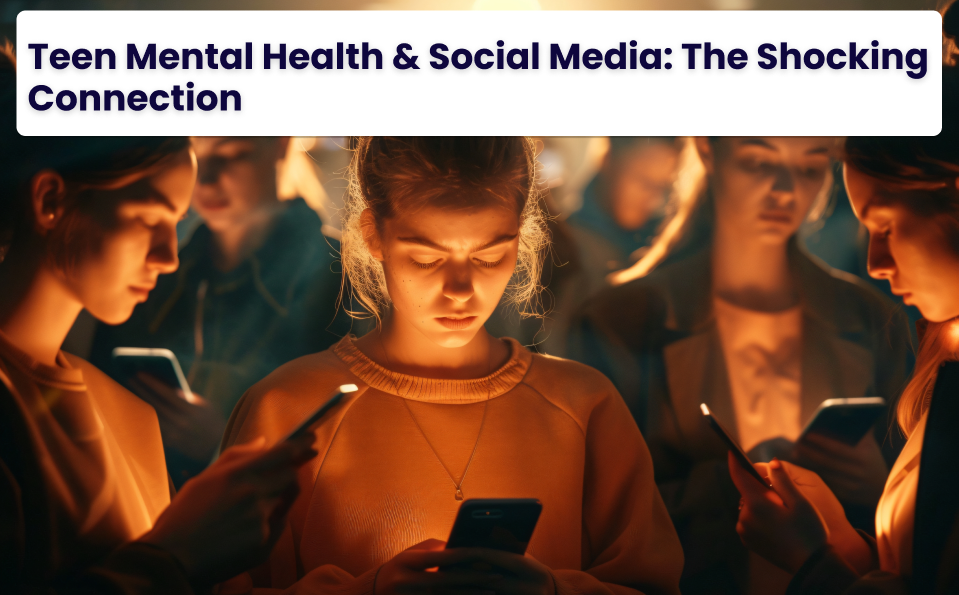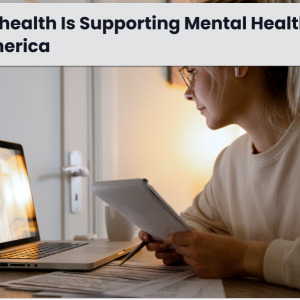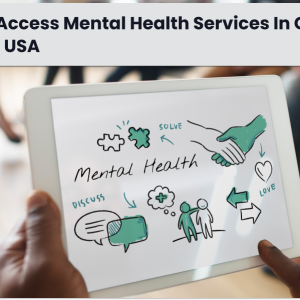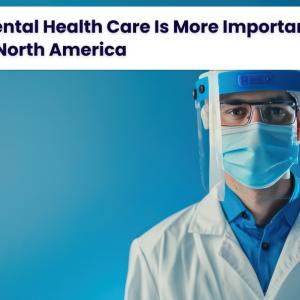
The Connection Between Mental Health and Social Media Use in Teens
In today’s fast-paced digital world, social media has become a cornerstone of teenage life. Platforms like Instagram, TikTok, and Snapchat are more than just apps—they’re spaces where teens build friendships, share milestones, and explore their identities. Yet, beneath the surface, the relationship between social media and teen mental health reveals a mix of benefits and challenges.
For parents, educators, and health professionals, understanding this connection is key to supporting teens in navigating their online world safely.
In this blog, we’ll explore the complex relationship between social media and teen mental health, delving into the potential negative and positive effects, and offering practical tips for promoting a healthy balance.
The Prevalence of Social Media in Teen Life

A 2022 survey by Pew Research Center found that 95% of teens in the USA have access to a smartphone, and over 90% use social media. In Canada, similar trends show that the majority of teens spend hours daily on social platforms. This widespread use means that social media is often where teens form their sense of identity, build relationships, and even learn about current events. But with this significant amount of time spent online comes the risk of negative mental health consequences.
Negative Impacts of Social Media on Mental Health
While social media can be a valuable tool for connection and self-expression, it can also contribute to several mental health challenges, especially for teens.
1. Increased Anxiety and Depression
Several studies have linked excessive social media use with increased rates of anxiety and depression among teens. One reason for this is that social media often presents a distorted version of reality. When teens constantly see curated, filtered, and “perfect” images of their peers, it can lead to feelings of inadequacy or insecurity about their own lives.
Why It Happens:
- Teens may feel pressure to present themselves in a certain way to receive validation through likes and comments.
- Fear of missing out (FOMO) is common, as they see others enjoying activities or experiences they may not be a part of.
- Constant comparison with peers can fuel low self-esteem and body image issues, especially when influenced by beauty and lifestyle standards often showcased on social media.
2. Cyberbullying and Online Harassment
Social media platforms can also become breeding grounds for cyberbullying. Teens are particularly vulnerable to online harassment, with many experiencing negative comments, exclusion, or threats in digital spaces. This can have profound effects on their mental well-being, leading to increased feelings of loneliness, fear, and depression.
Why It Happens:
- The anonymity of social media allows individuals to say hurtful things without immediate consequences.
- Cyberbullying often feels inescapable, as teens can be harassed not only at school but also online at all hours.
3. Sleep Disruptions
Teens who spend too much time on social media may experience disrupted sleep patterns. Studies have shown that teens who are active on social media late at night are more likely to suffer from sleep deprivation, which, in turn, negatively impacts their mental health.
Why It Happens:
- The blue light emitted from smartphones disrupts the body’s natural sleep-wake cycle.
- Social media notifications can disturb sleep, and teens often feel compelled to check their phones even in the middle of the night.
Positive Aspects of Social Media for Teens

While the potential downsides of social media are significant, it’s important to recognize that these platforms can also provide valuable benefits for teen mental health when used responsibly.
1. Support Networks and Communities
For teens struggling with mental health issues, social media can provide a sense of connection and belonging. Many platforms offer support groups or communities where teens can share their experiences and seek advice. This is particularly valuable for those dealing with anxiety, depression, or identity issues, such as those related to gender or sexual orientation.
Why It Works:
- Online communities allow teens to connect with others who are going through similar challenges, reducing feelings of isolation.
- Social media can offer resources, such as mental health support groups, crisis helplines, and informative content from trusted organizations.
2. Self-Expression and Creativity
For many teens, social media serves as a creative outlet where they can express their identity and artistic abilities. Whether it’s through sharing photos, creating videos, or writing posts, these platforms offer an opportunity for teens to explore their passions and develop their voice.
Why It Works:
- Social media provides a platform for self-expression, allowing teens to showcase their creativity in ways they might not be able to in their daily lives.
- Positive feedback from peers can boost self-esteem and reinforce a sense of accomplishment.
3. Social Connection and Friendships
For teens who may feel socially isolated or have difficulty forming friendships in person, social media can offer an avenue for making connections. It’s especially useful for maintaining long-distance friendships or communicating with peers who share similar interests.
Why It Works:
- Social media allows teens to stay connected with friends regardless of physical distance.
- It provides an opportunity to bond over shared interests, such as hobbies, music, or pop culture.
How Parents and Guardians Can Support Healthy Social Media Use

Given the potential risks and benefits of social media for teens, finding a balance is key. Here are some ways parents and guardians can help teens maintain a healthy relationship with social media:
1. Set Boundaries
Establishing clear limits on screen time is important. Encourage teens to take breaks from social media, especially before bedtime, to avoid sleep disruptions. Setting time limits on apps can also help manage excessive use.
2. Foster Open Communication
Create an environment where teens feel comfortable discussing their social media experiences. Whether it’s dealing with cyberbullying or feeling overwhelmed by comparison, being able to talk about these challenges can make a big difference in managing their mental health.
3. Encourage Positive Social Media Habits
Help teens identify the positive aspects of social media and encourage them to use platforms to connect with supportive communities or explore their creativity. Additionally, educating them on the importance of curating their social media feed to follow uplifting, positive accounts can reduce the harmful effects of comparison.
4. Be a Role Model
Parents should also be mindful of their own social media use. Modeling healthy behavior by taking breaks from devices, prioritizing face-to-face interactions, and maintaining a healthy balance between screen time and real-life activities sets a positive example for teens.
Summary
Social media plays a significant role in the lives of teens, offering both positive and negative impacts on their mental health. While it can contribute to anxiety, depression, cyberbullying, and sleep disruptions, it also offers valuable support networks, opportunities for self-expression, and ways to stay socially connected. To ensure a healthy balance, it’s important for teens to set boundaries, connect with positive communities, and practice mindful social media habits. Parents and guardians can play a critical role by fostering open communication and modeling responsible behavior.





